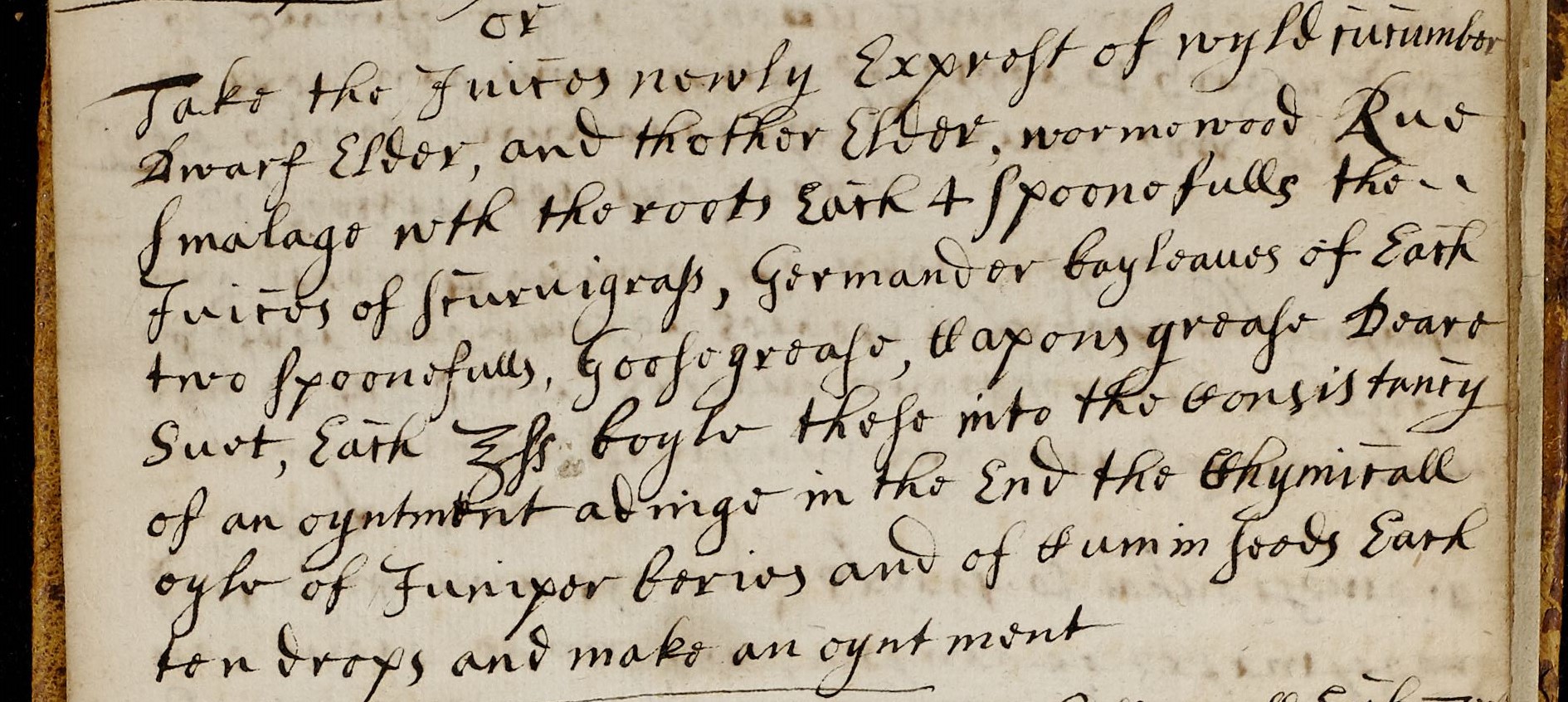Related pages
Investigating recipes: What makes a good recipe?
Enjoy the first in a series of blogs focussing on each of the elements which make up a successful recipe.
Pamela Forde
On 4 November 2022 we are joining with the Early Modern Recipes Online Collective (EMROC) and the Wellcome Collection for a Transcribathon where participants form all over the world can take part in transcribing texts from our archives and enjoy talks and activities about early modern recipes throughout the day. Manuscript MS502, ‘A collection of medical receipts and prescriptions’, from our archives has been chosen as our text for transcription.

In modern times we take the availability of items we rely on for our daily needs for granted. Before the industrial age and the development of reliable mass transport, most communities had to make do with what could be sourced locally. The distance a horse could travel over a day, especially pulling a vehicle, was the limit of easy travel. Without planes, trains and automobiles, shipping was the only method of long-distance transport.
This means settlements were more isolated and had to be more self-reliant than we can imagine today. One result was that recipe books used in areas with fewer opportunities to buy the necessities and luxuries of life, were much more inclusive in the variety of products listed. Exotic ingredients (those sourced from rare products or from overseas) were limited in availability and expense.
As a result, the ingredients listed in recipes can provide valuable clues as to both the area a recipe came from and the social status/wealth of the author. Recipes with hard to find or expensive ingredients can be assumed to be the product of wealthy authors, or at least authors with easy access to those items.
The names used for certain plants can also provide clues as to the location of the author, if the names vary from region to region. Plant names also change over time, so clues as to the time period the recipe was created may be found. The inclusion or exclusion of certain ingredients can itself be a clue, if those ingredients were imports which only started in a certain time period. Or perhaps when a previously rare and expensive item is available widely enough, cheaply, it starts to be a staple recipe ingredient.
However, these assumptions can be taken too far. Most modern cookery books contain a range of recipes, from the everyday store cupboard kind to the special occasion with luxury ingredients kind. The 17th century recipe book was very similar, with recipes across a range in terms of practicality and expense.
Because recipes were swapped and traded, so the source of a specific recipe doesn’t necessarily tell you anything about the volume it ends up in. Local names may have been forgotten over time. This can make both the ingredients and the source of a recipe impossible to identify.
Not all the ingredients in recipes were thought to have healing properties. Some ingredients were included as a carrier for the treatment, usually wine or ale. Others would improve the taste, such as sugar. I would imagine that, just like today, if a certain ingredient was not available, a similar substitute would be used. In this way recipes may have evolved and changed from user to user, place to place.

Seasonal availability was also a factor when it came to harvesting and using plants or other organic ingredients. Flowers would not be available in autumn or winter and many plants would only be plentiful during the growing season. Before refrigeration, animal product had to be used while fresh. All of the above can perhaps partly explain why there would be so many variants of recipes for treating the same condition.
As with so many elements of early modern medical recipes, there isn’t enough historical record we can rely on when researching the practical applications of these fascinating volumes. The full story will always be beyond our grasp.
Manuscript MS502, “A collection of medical receipts and prescriptions” is from the archive collections of the Royal College of Physicians. This handwritten volume has been chosen as one of the items included in the EMROC 2022 November Transcribathon. This takes place on 4 November 2022. See here for more details and how to get involved.
A complete digital copy of this manuscript is available, in an online collection of RCP medical recipe books, in the Internet archive, here.
To accompany the Transcribathon, we are producing a series of blogs about manuscript 502, focussing on each of the elements which make up a successful recipe. See here for the previous blog in this series.
The third blog in the series on accessible methods, “Investigating recipes: How to boil an egg” will be published soon.
For more information on this, and the other fascinating items which make up the archives of the Royal College of Physicians, see here.
Pamela Forde, archives manager
